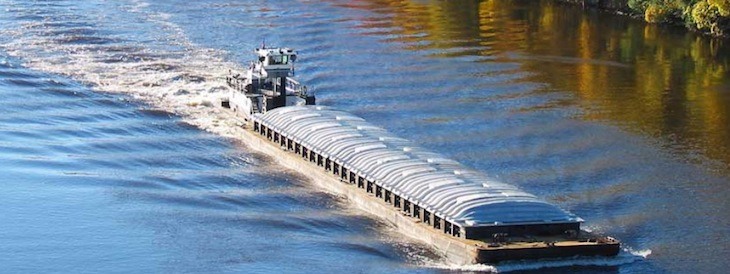Commercial Arkansas River traffic gains muted by rains, high water levels
by May 23, 2017 2:14 pm 583 views

The 2017 rebound shaping up for commercial tonnage on the Arkansas River faced a setback in April and could see a tough May and June if rain continues to fall in Oklahoma watersheds.
Traffic through the first three months of 2017 on the Arkansas River (McClellan-Kerr Arkansas River Navigation System) totaled 3.246 million tons, up 10% compared with the January-March period of 2016. It was the first time since 2014 (3.062 million tons) that tonnage on the Arkansas River has topped the 3 million mark the first three months of the year.
However, rains that began to fall in March and through April in areas of Oklahoma feeding into the Arkansas River watershed resulted in river levels that began to slow and eventually halt shipping on the river.
April tonnage totaled 840,871, according to the U.S. Corps of Engineers, down 17.4% compared with the 1.018 million tons in April 2016. It was the first April total to dip below 900,000 tons since 2011 (825,318 tons). For the first four months of the year tonnage has totaled 4.087 million tons, up 3.2% compared with the same period in 2016.
Tonnage is not likely to improve in May and could be down in June, especially if rainy weather persists. For example, on May 22, the Corps closed the Arthur Ormond Lock & Dam (near Morrilton) because of high water levels. That closes a significant portion of the Arkansas River from access to the Mississippi River.
The Arkansas River system is 445 miles long and stretches from the confluence of the Mississippi River to the Port of Catoosa near Tulsa, Okla. The controlled waterway has 18 locks and dams, with 13 in Arkansas and five in Oklahoma. The river also has five ports: Pine Bluff, Little Rock, Fort Smith, Muskogee, Okla., and the Tulsa Port of Catoosa in Oklahoma.
LITTLE ROCK, FORT SMITH AREA PORTS
Bryan Day, executive director of the Little Rock Port Authority, said river conditions have stopped traffic but have not yet halted port operations.
“The Arkansas River has had high flows for the past several weeks and barge traffic has stopped. We hope the river will reopen next week. As of today (May 23), barge traffic has not returned to normal. Although some of our industry partners have been slightly inconvenienced, the slowdown in river traffic has not impacted any jobs or economic development efforts,” Day said in a note to Talk Business & Politics.
The assessment was similar from Marty Shell, owner of Five Rivers Distribution, which operates port facilities in Fort Smith and Van Buren. He said around 20 barges are anchored in the area, with the last barge moved on April 25. Shell said conditions have yet to reach what happened in 2015, but another 4 or 5 inches of rain in just a few days would begin to come close. What’s more, there are seven lakes in Oklahoma that continue to drain into the river long after the rains go, Shell said.

Thanks to unusual amounts of rainfall in 2015, tonnage on the Arkansas River was down 15% compared with 2014, and fell below 10 million tons for the first time in at least four years.
Shell is hoping river levels allow shipping to continue by June 15 – which would mark 45 days that river conditions halted barge traffic at the ports in Van Buren and Fort Smith. Primary products handled by Shell’s operations include steel for manufacturers in Fort Smith and Northwest Arkansas, and cattle, poultry and pork feed for regional agri customers.
“They (Corps) are telling us we could go again by June 15. … But that’s if we don’t get more rain,” Shell said, adding that the Corps has worked well to communicate with river port operators.
If the rains continue and river levels don’t decline, warehouses could run out of product to manage and ship, and Shell still has to keep port employees on the clock.
“When that happens, we do a lot of sweeping, a lot of grass cutting, a lot painting. Just something to keep everyone busy,” Shell explained. “We have about 25 workers. That’s 25 families I worry about every night.”
Northwest Arkansas Business Journal Editor Paul Gatling contributed to this report.
